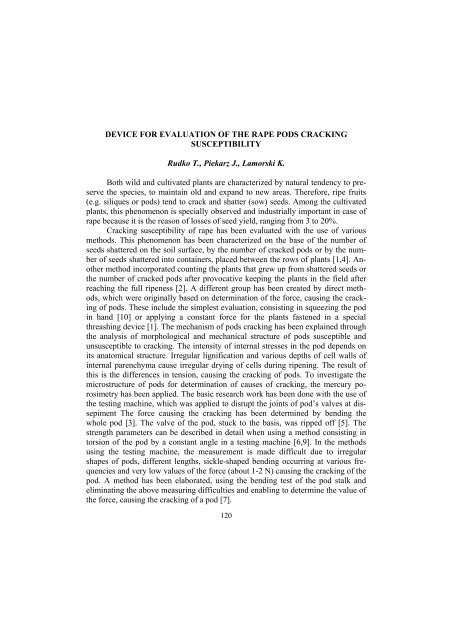C - Lublin
C - Lublin
C - Lublin
You also want an ePaper? Increase the reach of your titles
YUMPU automatically turns print PDFs into web optimized ePapers that Google loves.
DEVICE FOR EVALUATION OF THE RAPE PODS CRACKING<br />
SUSCEPTIBILITY<br />
Rudko T., Piekarz J., Lamorski K.<br />
Both wild and cultivated plants are characterized by natural tendency to preserve<br />
the species, to maintain old and expand to new areas. Therefore, ripe fruits<br />
(e.g. siliques or pods) tend to crack and shatter (sow) seeds. Among the cultivated<br />
plants, this phenomenon is specially observed and industrially important in case of<br />
rape because it is the reason of losses of seed yield, ranging from 3 to 20%.<br />
Cracking susceptibility of rape has been evaluated with the use of various<br />
methods. This phenomenon has been characterized on the base of the number of<br />
seeds shattered on the soil surface, by the number of cracked pods or by the number<br />
of seeds shattered into containers, placed between the rows of plants [1,4]. Another<br />
method incorporated counting the plants that grew up from shattered seeds or<br />
the number of cracked pods after provocative keeping the plants in the field after<br />
reaching the full ripeness [2]. A different group has been created by direct methods,<br />
which were originally based on determination of the force, causing the cracking<br />
of pods. These include the simplest evaluation, consisting in squeezing the pod<br />
in hand [10] or applying a constant force for the plants fastened in a special<br />
threashing device [1]. The mechanism of pods cracking has been explained through<br />
the analysis of morphological and mechanical structure of pods susceptible and<br />
unsusceptible to cracking. The intensity of internal stresses in the pod depends on<br />
its anatomical structure. Irregular lignification and various depths of cell walls of<br />
internal parenchyma cause irregular drying of cells during ripening. The result of<br />
this is the differences in tension, causing the cracking of pods. To investigate the<br />
microstructure of pods for determination of causes of cracking, the mercury porosimetry<br />
has been applied. The basic research work has been done with the use of<br />
the testing machine, which was applied to disrupt the joints of pod’s valves at dissepiment<br />
The force causing the cracking has been determined by bending the<br />
whole pod [3]. The valve of the pod, stuck to the basis, was ripped off [5]. The<br />
strength parameters can be described in detail when using a method consisting in<br />
torsion of the pod by a constant angle in a testing machine [6,9]. In the methods<br />
using the testing machine, the measurement is made difficult due to irregular<br />
shapes of pods, different lengths, sickle-shaped bending occurring at various frequencies<br />
and very low values of the force (about 1-2 N) causing the cracking of the<br />
pod. A method has been elaborated, using the bending test of the pod stalk and<br />
eliminating the above measuring difficulties and enabling to determine the value of<br />
the force, causing the cracking of a pod [7].<br />
120
















